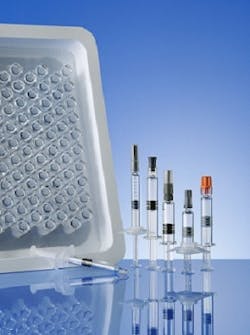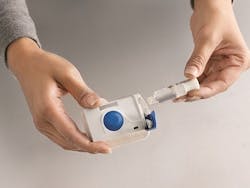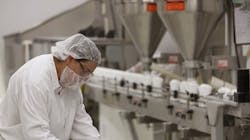It's hard to understate the critical role pharmaceutical packaging plays in ensuring the efficient distribution and eventually, the safe consumption of the world's drug supply. Much of where the category is today (and all that it brings to Pharma) stems from an amazing confluence of operational and technological wisdom gained from years and years of applicational experience across all sectors of the industrial landscape.
Seriously essential, packaging has always delivered, but in 2015 it's being asked to deliver even more to meet Pharma's ever-expanding demand for packaging solutions. From the materials and science associated with primary packaging, to the increasing sophistication and integration of drug delivery platforms and single-dose-unit forms, packaging is playing an increasingly integral role supporting the medical success of a given compound.
Single-dose unit prefillable syringes are an increasingly popular primary packaging form. When offered pre-sterilized and ready to fill in machine-ready trays like these units from Gerresheimer. (Photo courtesy of Gerresheimer)
World pharmaceutical packaging demand, says The Freedonia Group, will increase 6.4 percent annually to $90 billion in 2017. According to Freedonia's "World Pharmaceutical Packaging" report, "Based on the operation of extensive and diverse drug-producing industries, Western Europe, the U.S. and Japan will account for nearly 60 percent of this amount." Not surprisingly, the report notes countries like India and China will experience the fastest product demand growth from "rapidly expanding pharmaceutical manufacturing capabilities, burgeoning drug exports, and the phasing-in of an extensive government program designed to upgrade the quality and integrity of nationally produced medicines." Who's coming up the fastest? Brazil, Mexico and Turkey were identified as fast-growing pharmaceutical packaging product markets.As per usual, the U.S. will remain the largest market for pharmaceutical packaging "as its advanced drug-producing sector introduces new, sophisticated therapies with specialized packaging needs." Freedonia notes growth in West European demand will reflect government standards requiring unit-dose, high-barrier and security packaging for many types of medications. Japan, says the report, will also continue to provide a large, diverse market for pharmaceutical packaging.
FAST GROWTH PREDICTED FOR PREFILLABLE SYRINGES
Global demand for primary pharmaceutical containers, says Freedonia's analysts, will increase 6.6 percent annually to over $57 billion in 2017. Prefillable syringes, notes the report, will be in high demand, and the list of suppliers and vendors pursuing the potential revenue from this category are becoming legion; Becton Dickinson , Gerresheimer, SCHOTT, Vetter and West (to name just a few top players) are all positioning themselves strategically and operationally to deliver solutions to meet this burgeoning demand.
Demand for prefillable, injectable, single unit dose forms is being driven by a number of factors but Freedonia and others point out the advances in the biotechnology sector will mean a steady stream of parenteral therapies requiring prefillable solutions to deliver these therapies to consumers. West Pharmaceutical Packaging Systems' Mike Schaefers notes his company is seeing growing demand from customers for pure, high-quality packaging components for injectable biologics and biosimilars. "Many biotech and sensitive drug products have unique requirements, and polymer systems provide key solutions for patient safety and compliance," says Schaefers. "There are a variety of products on the market that can help mitigate these risks, including barrier films for elastomer components that help to reduce potential extractables and leachables formation," he says, but "for materials that are sensitive to glass, cyclic olefin polymers can be molded into a variety of shapes and sizes to accommodate not only the drug product, but also large-volume doses. In addition, cyclic olefins can be molded to suit innovative delivery devices, offering differentiation in the market." Ultimately, says Freedonia, that megatrend will also fuel "above average growth" in demand for parenteral vials and ampoules because the category will increase demand for those vessels as well.
West's SmartDose system is an excellent example of how West collaborates with biotech companies to offer fully integrated drug delivery systems designed to meet patient needs. (Photo courtesy of West)
MESSAGE IN THE BOTTLEDespite increasing competition from highly engineered, unit-dose and prefillable solutions, plastic bottles will "remain the most widely used package globally for oral drugs distributed in bulk," notes Freedonia's report. Plastic bottle's penetration into Over-the-Counter (OTC) packaging will continue because many OTC medicines are sold in oral solid dose forms and in quantities of 50 or more.Blister packaging is a rising star and Freedonia's study confirms this. Blister packaging of single doses are at the forefront of how Pharma is responding to the market and regulator's demand to improve dose compliance and therefore safety — not to mention the overall efficacy and improved outcomes of therapies administered this way. "Blister packs are becoming more popular as they can improve patient compliance and can be customized to fit a product design due to the availability of a broad range of materials and multiple configuration options," notes Gordon Haines, Rottendorf Pharmaceuticals' CEO. Rottendorf packages more than 3 billion tablets, capsules and pills a year on nine blister lines and two bottle lines. "Blister packs also protect product integrity, allowing patients to select one pill at a time while leaving the others untouched," says Haines, "as opposed to bottles where a patient might dump out a handful of pills in order to select just one."Freedonia's report says it has become the second-largest selling group of primary pharmaceutical containers "and will generate above average growth in demand based on adaptability to unit dose and clinical trial formats with expanded label content, high visibility, and built-in track and trace features."Tee Noland, CEO of Pharma Tech Industries (annual sales ~$80 million) notes customers are looking for innovation from a cost and quality perspective. "We are … seeing a lot of interest in unique delivery systems as line extensions, says Noland, "and more emphasis on single-dose forms from a portability and ease-of-use perspective." Noland also notes his customers are showing more interest in vertically integrating production points like packaging, manufacturing and molding, as well as onsite testing.
Prefillable inhaler's stock is rising, too. Due to the increasing number of patients diagnosed with COPD, chronic asthma, and allergy related respiratory symptoms, Pharma's introducing and regulators are approving new inhalable therapies at a pretty good pace. Further, some of these medications are going off-patent and Generic Pharma will not be ignoring the potential in this category any time soon.
West Pharmaceutical Delivery Systems' vice president Graham Reynolds illuminates how Pharma, and more importantly consumers, are pushing for increasingly sophisticated delivery modalities. "Historically," says Reynolds, "the primary focus of pharmaceutical manufacturers has, appropriately, been on the efficacy and safety of their drug product. However, with more drugs coming onto the market as combination products — drug products paired with delivery devices — pharmaceutical companies are paying closer attention to the design, function and efficacy of integrated delivery systems." Reynolds says a successful integrated system will combine the needs of the patient at a variety of stages during the patient journey with the drug, its primary containment system and its delivery system.
SECURITY FROM THE OUTSIDE IN
Beyond packaging's broadening role as the means and medium if you will, to provide both physical and virtual security in the supply chain, packaging is also being called on to help solve the knotty problems of dose compliance. According to the Healthcare Compliance Packaging Council, pharmaceutical noncompliance is a tremendous problem in the U.S.: "Estimated annual costs [associated with] patients not taking their medications approaches $300 billion. It is also estimated that 125,000 Americans die annually (342 people every day) due to poor medication adherence and 10 - 25 percent of hospital and nursing home admissions are also caused by people's inability to take their medications as prescribed."
Tom Hubbard, the New England Healthcare Institute's VP of Policy Research noted in a PMP.com report last year "There is no question that packaging is a part of the overall strategy to addressing medication adherence," noting medication adherence is a metric in the quality ratings for Medicare drug plans. "Payers and providers are thinking more strategically about adherence, said Hubbard, "Healthcare plans are trying to figure out the right mix of steps to keep patients adherent and head off overall medication spending. Packaging is part of that response."
Tee Noland, CEO of Pharma Tech Industries (packaging line operator shown here) notes customers are looking for innovation from a cost and quality perspective. (Photo courtesy of Pharma Tech Industries)
Mike Schaefers, also a marketing VP with West Pharmaceutical Packaging Systems, says his company is seeing strong growth in creative collaborations between drug manufacturers and packaging and delivery systems manufacturers much earlier in the drug development process. "To achieve the best possible patient outcomes, pharmaceutical companies developing injectable therapies must consider how the drug product will interact not only with the primary container, but also with the delivery system and the patient to help ensure compliance to prescribed regimens and loyalty to specific brands," explains Schaefers. According to Schaefers, by partnering with a component manufacturer early in the drug development process, pharmaceutical manufacturers can identify and mitigate many of the risks associated with hasty or poorly vetted containment selection.SUPPLY CHAIN SECURITY OFFICER
Packaging is also being tasked to deliver improved supply chain security. "Implementing a Pharmaceutical Serialization and Traceability System in the United States," a study by consultancy Booz | Allen | Hamilton, noted in its executive summary that the U.S. pharmaceutical supply is considered one of the world's safest and the distribution system was well regulated. But on the other hand, critics note that the bulk, wholesale distribution of medications to and through pharmacy distribution networks, while proven safe and effective in the past provide an antiquated system that just isn't up to the task of interdicting the activities of very bad and sophisticated actors looking to profit from the nefarious trafficking of counterfeit, substandard and outright fake drugs.
Last year Walter Berghahn, The Healthcare Compliance Packaging Council's Executive Director, offered testimony before a House Energy and Commerce Subcommittee Hearing on Supply Chain Security. In his letter, he concluded that supply chain security should include the "patient" and noted the following about packaging's role in drug security and safety:
• Driving the serialized container through the pharmacy to the patient will virtually eliminate dispensing errors that occur regularly in today's "count, pour, lick and stick" environment.
• Putting an original manufacturer's container in patient's hands will allow them to authenticate the package.That same container, or more appropriately the serial barcode, will allow patients to link to a variety of compliance tools which will allow them to track their individual performance and link them to a variety of reminder tools.
• Serial numbers could create the opportunity for direct-to-consumer notification of recalls, unlinking the dependency on pharmacists to track the lot and then research which patients' scrips were filled from that lot, etc.
• Serial numbers could be used in reverse logistics to prevent the re-issuance of a container that was already delivered into the market place and left the care of a professional controlled environment.
• Serialized containers would ease the process of reverse logistics, returns. No more diverted returns.
Vetter, a well-known contract manufacturer and complex secondary packaging specialist, offers serialization at the carton (sales unit) level and aggregation at the carton (sales unit), shipping case, and pallet levels. Like others in its peer group, Vetter recognized that fundamental serialization services at the point of secondary packaging operations is something its existing customers need right now and something potential customers will likely want well into the future. Vetter says its serialization and aggregation services are seamlessly integrated into its primary packaging processes. Vetter says this service helps its clients establish "the 'parent-child' relationships among components and understand the exact contents of a product package at any point."
The point is, most of the physical aspects of serialization, the marking of primary and secondary packaging, and most of its associated data are gathered at this point in Pharma manufacturing operations. It's here where enterprise data and the physical manipulation of the products meet and the point where the handoff to logistics providers and others take possession of these goods. The prevailing wisdom is that there is much opportunity to optimize supply chain operations.
Serialization, explains UPS Healthcare marketing director Robin Hooker, offers Pharma tremendous opportunity. "Every bottle will have its own birth certificate, passport and social security number, and in essence, once that happens you've got a tremendous way of visualizing the supply chain." Hooker explains that "if this transaction data gets handed off through every supply chain actor from the manufacturer, to UPS Freight [and on] to a distributor, then from distributor to drug retailer or specialty pharmacy, those handoffs and that visibility and that information is going to do amazing things for supply chain optimization."
FUNCTION JUNCTION
It's at this junction where the integration of data and production systems simply cannot be an afterthought. Most MES platform suppliers including Rockwell, Siemens, SAP, Werum and others know that information technologies, well integrated with packaging line production equipment, all married to machine vision and marking and labeling technologies will deliver efficiency gains that have far-reaching positive effects operationally.
CONTRACT PACKAGERS
Across Pharma's operational landscape, contract manufacturing organizations (CMOs) are doing the heavy lifting associated with packaging and packaging operations. For many drug owners, there's plenty of incentive to bring in contract packaging solutions providers from both a design and commercial packaging operations standpoint.
"Our customers want a reliable, high-quality operation that will help them meet new serialization requirements without having to make the capital investment themselves," says Rottendorf's Haines. To accomplish this, he says, Rottendorf works consultatively to design packaging to cost targets, "by providing more cost effective and efficient materials and operations," notes Haines.
"Consumers want a package that is easy to use and straightforward," says Pharma Tech Industries Noland, "you are seeing this with some of the new virtual companies that are developing certain OTC products. In terms of our organization, we have made more investment into our unit-dose capability suite to support these opportunities."
Blister packs says, Gordon Haines, Rottendorf Pharmaceuticals CEO are becoming more popular as they can improve patient compliance and can be customized to fit a product design due to the availability of a broad range of materials and multiple configuration options. (Photo courtesy of Rottendorf)
West's Schaefers explains that everything in the value chain cannot be a core competency, "so outsourcing makes sense on many levels. Quality expectations are increasing, and as a result customers seek solutions to improve product quality and ensure drug integrity." Schaefers says West continues to make significant investments in vision inspection systems as more customers demand 100 percent inspection of components.THE EARLIER THE BETTER
With packaging playing such a significant role in the commercial success of today's pharmaceuticals, it makes tremendous sense to include CMOs and contract packagers in on product development as early as possible. "Packaging choices can have a significant impact on the finished cost of a product," says Haines. "If packaging suppliers are involved early in the process, appropriate packaging can be designed and optimized for dependability and cost." Yet it's not all peace and harmony out there, he says. "While the mindset of companies is starting to change, many pharma companies still treat packaging as an afterthought. We try to make our customers aware of the potential impacts of incorporating packaging design early, to try to move it up on their list of priorities, but practice is still behind where it needs to be."
"In some cases," says Noland, "we are seeing this collaboration at the early part of the drug development cycle because packaging can comprise a significant part of a product's cost. Not only are we looking at specific packaging projects, but also technology transfers of entire operations or even entire sites. These more strategic activities allow our customers to rationalize their supply chain and simplify their business exponentially."
LET'S GET RATIONAL
The complexities of Pharma's supply chain, its limitations and its contributions to drug safety are well recognized by the industry, its contract services providers and its technology suppliers. Best practice involves getting resources and technologies aligned early for best effect. Noland's comment regarding rationalizing the supply chain has everything to do with successfully fielding well-integrated packaging operations and leveraging them to answer the halo of issues associated with supply chain security and dose compliance by consumers. Yes, packaging is bringing a lot to Pharma, and it appears it is ready to take delivery.









